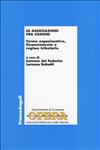
LIBRI DI LORENZO ROBOTTI


The Law 42/09 represents an important step towards fiscal federalism in Italy. In particular, the Law places its foundation on the principles of territoriality, fiscal autonomy and fiscal equalization in order to abandon the criterion of historical expenditure in favor of «standard costs». A standard level of services must be provided by the local governments which must finance the expenditures mainly with their own tax revenues. In case the revenues are not adequate to cover the «standard» financial needs, the central government intervenes with equalization transfers. The definition of «standard criteria» therefore represents a crucial phase in the whole reforming process. The amount of central government transfers in fact depends on the flexibility of these criteria. Since the law gives very few indications on how to calculate the «standard costs/revenues», in this work we propose some alternative evaluations of these and assess the impact that different approaches can have on the central and local budgets using a CGE (Computable General Equilibrium) model based on a bi-regional SAM (Social Accounting Matrix) for Italy for 2003.

L'approccio economico al federalismo fiscale - Local governance in its broadest form predates the modern nation-state. Contemporary local government arose from historical accident rather than by deliberate design and its subsequent evolution represents the outcome of constitutional reform, legislative change, political opportunism, popular agitation, urbanization, technical progress and a host of many other incidental influences. Scholars from a wide range of different disciplines have nonetheless sought to construct theoretical principles that can explain the nature of local government. We provide a synoptic review of the chief contributions of economics to contemporary understanding of local government in advanced democratic countries. In so doing we consider both normative economic theories of local government, which seek to provide a framework for how local government should be organized, and positive economic theories which attempt to explain why local government functions as it does.

Forme organizzative, finanziamento e regime tributario
La dimensione demografica ideale di un ente territoriale di base si attesta fra i 20.000 e i 40.000 abitanti; in Italia i comuni di tale consistenza sono poco più di 250 su 8.104, e ben 4.770 hanno meno di 3.000 abitanti: un ostacolo alla gestione efficiente delle funzioni amministrative e dei servizi locali. Il volume analizza le strutture amministrative e le forme di gestione e finanziamento dell’associazionismo comunale.
cod. 380.345

cod. 380.322

Teoria economica ed esperienze concrete
cod. 380.325

cod. 380.282

cod. 380.262


cod. 380.207

Recent changes in the regulations concerning the treatment of waste water imply a number of technical requirements that purification plants must satisfy. These requirements are not met by most Italian plants. Therefore, a large amount of investment will be necessary in the near future. The aim of this paper is to investigate scale and characteristics of economic inefficiency in the purification process, particularly in the activity of nitrogen reduction in waste water. The analysis has been accomplished by using recently developed techniques in the analysis of stochastic production frontiers. It is argued in the paper that, when technical efficiency is achieved by a lant, there is evidence of non-decreasing returns to scale; on the contrary, enlarging a plant is likely to be ineffective if allocative efficiency is not achieved.

cod. 1390.7